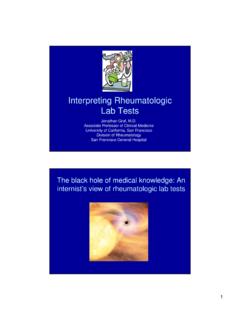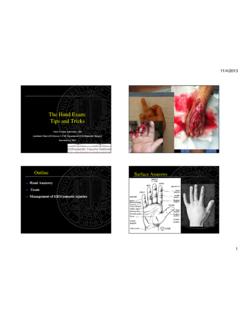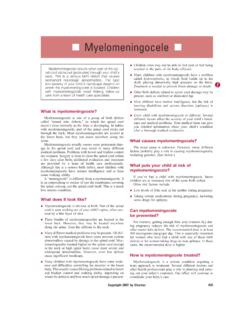Transcription of Common “Abnormal” Ultrasound Findings: What …
1 6/5/20081 Common abnormal Common abnormal Ultrasound findings : what Ultrasound findings : what Should I Tell My Patient?Should I Tell My Patient?Linda Hopkins MDLinda Hopkins MDUniversity of California, San FranciscoUniversity of California, San FranciscoJune 5, 2008 June 5, 2008 OverviewOverview Topics: echogenic intracardiac focus, choroid Topics: echogenic intracardiac focus, choroid plexus cyst, echogenic bowel, renal pelviectasis, plexus cyst, echogenic bowel, renal pelviectasis, single umbilical artery. If time permits: single umbilical artery. If time permits: ventriculomegaly, clubfoot, cleft lipventriculomegaly, clubfoot, cleft lip what it isWhat it is what it means (if anything) what it means (if anything) what to do about it antenatally and postnatallyWhat to do about it antenatally and postnatally what to say to your patientWhat to say to your patient Helpful websites for you and your patientHelpful websites for you and your patientGoalsGoals Review 8 Ultrasound findings : EIF, CPC, Review 8 Ultrasound findings .
2 EIF, CPC, echogenic bowel, renal pelviectasis, SUA, echogenic bowel, renal pelviectasis, SUA, ventriculomegaly, clubfoot, cleft lipventriculomegaly, clubfoot, cleft lip Review briefly the implications of these findings Review briefly the implications of these findings and the workup recommended, if anyand the workup recommended, if any Be able to discuss these findings with your Be able to discuss these findings with your patients either comprehensively or as a bridge patients either comprehensively or as a bridge to MFM consultationto MFM consultationEchogenic Intracardiac FocusEchogenic Intracardiac Focus6/5/20082 Echogenic Intracardiac FocusEchogenic Intracardiac Focus what is it? what is it? An echogenic (bright) spot in the left cardiac ventricleAn echogenic (bright) spot in the left cardiac ventricle Correlates to mineralization (calcification) of the Correlates to mineralization (calcification) of the papillary musclepapillary muscle what does it mean?
3 what does it mean? Present in 3 Present in 3--4% of normal fetuses 4% of normal fetuses Can be associated with trisomy 21 : approximately 18% Can be associated with trisomy 21 : approximately 18% of fetuses with trisomy 21 have an EIFof fetuses with trisomy 21 have an EIF Therefore, in a highTherefore, in a high--risk population, does increase the risk population, does increase the risk of chromosomal abnormalitiesrisk of chromosomal abnormalities In a lowIn a low--risk population, the increase in risk is usually risk population, the increase in risk is usually not substantial and the finding is a normal variant not substantial and the finding is a normal variant Echogenic Intracardiac FocusEchogenic Intracardiac Focus what to do about it: PrenatalWhat to do about it: Prenatal Confirm the finding truly exists: false positives are Confirm the finding truly exists: false positives are possiblepossible Look for other markers or malformations associated Look for other markers or malformations associated with chromosomal abnormalities and review screening with chromosomal abnormalities and review screening test resultstest results If other findings are seen, or if the patient is considered If other findings are seen, or if the patient is considered highhigh--risk for chromosomal abnormalities, refer to risk for chromosomal abnormalities, refer to genetics/ prenatal diagnosisgenetics/ prenatal diagnosis what to do about it: PostnatalWhat to do about it: Postnatal Nothing: of no significance Nothing.
4 Of no significance Echogenic Intracardiac FocusEchogenic Intracardiac Focus what to say to your patientWhat to say to your patient EIF is an Ultrasound finding that is usually normal and EIF is an Ultrasound finding that is usually normal and of no significance. It does not mean there is anything of no significance. It does not mean there is anything wrong with the heart and in fact, we do not recommend wrong with the heart and in fact, we do not recommend doing anything about it even after birth. doing anything about it even after birth. In women who are at a higher risk for having a baby In women who are at a higher risk for having a baby with trisomy 21 especially if other findings are seen on with trisomy 21 especially if other findings are seen on Ultrasound , we do like to sit down and discuss what this Ultrasound , we do like to sit down and discuss what this finding may mean for may mean for Plexus CystsChoroid Plexus Cysts6/5/20083 Choroid Plexus CystsChoroid Plexus Cysts what is it?
5 what is it? Cystic areas seen in the lateral ventricles of the brain Cystic areas seen in the lateral ventricles of the brain within the choroid plexus. They can be unilateral, within the choroid plexus. They can be unilateral, bilateral, single or , single or multiple. what does it mean? what does it mean? Present in in of normal fetuses of normal fetuses Can be associated with trisomy 18: approximately 30 Can be associated with trisomy 18: approximately 30--50% of fetuses with trisomy 18 have CPC50% of fetuses with trisomy 18 have CPC Fetuses with trisomy 18 often have other findings on Fetuses with trisomy 18 often have other findings on Ultrasound . Isolated CPC therefore are more often seen Ultrasound . Isolated CPC therefore are more often seen with a normal a normal Plexus CystsChoroid Plexus Cysts what to do about it: PrenatalWhat to do about it.
6 Prenatal Look for other markers or malformations associated Look for other markers or malformations associated with trisomy 18 (clenched fist, strawberry shaped skull, with trisomy 18 (clenched fist, strawberry shaped skull, cardiac defect) and review screening test resultscardiac defect) and review screening test results If other findings are seen, or if the patient is considered If other findings are seen, or if the patient is considered highhigh--risk for trisomy 18, refer to genetics/ prenatal risk for trisomy 18, refer to genetics/ prenatal diagnosisdiagnosis Usually not seen after 23 weeks gestationUsually not seen after 23 weeks gestation what to do about it: PostnatalWhat to do about it: Postnatal Nothing: of no significanceNothing: of no significanceChoroid Plexus CystsChoroid Plexus Cysts what to say to your patientWhat to say to your patient CPC is an Ultrasound finding that is usually normal and CPC is an Ultrasound finding that is usually normal and of no significance.
7 It does not mean there is anything of no significance. It does not mean there is anything wrong with the brain and in fact, we do not recommend wrong with the brain and in fact, we do not recommend doing anything about it even after birth. doing anything about it even after birth. In women who are at a higher risk for having a baby In women who are at a higher risk for having a baby with trisomy 18, especially if other findings are seen on with trisomy 18, especially if other findings are seen on Ultrasound , we do like to sit down and discuss what this Ultrasound , we do like to sit down and discuss what this finding may mean for them. If no other findings are seen finding may mean for them. If no other findings are seen on Ultrasound and the previous screening tests have on Ultrasound and the previous screening tests have been favorable, we consider CPC of no clinical been favorable, we consider CPC of no clinical BowelEchogenic Bowel6/5/20084 Echogenic BowelEchogenic Bowel what is it?
8 what is it? A remarkably echogenic (bright) appearance to the fetal intestines. A remarkably echogenic (bright) appearance to the fetal intestines. The entire intestine or a discrete segment may appear entire intestine or a discrete segment may appear echogenic. Also called hyperechoic bowelAlso called hyperechoic bowel what does it mean? what does it mean? Present in of normal fetusesPresent in of normal fetuses Can be associated with trisomy 21: approximately 7 Can be associated with trisomy 21: approximately 7--12% of fetuses 12% of fetuses with trisomy 21 have echogenic bowelwith trisomy 21 have echogenic bowel Can be associated with congenital infections including CMV, Toxo, Can be associated with congenital infections including CMV, Toxo, HSV, parvovirusHSV, parvovirus Can be associated with cystic fibrosis (meconium ileus) in up to Can be associated with cystic fibrosis (meconium ileus)
9 In up to 20% of fetuses20% of fetuses Can be associated with bowel pathology including bowel Can be associated with bowel pathology including bowel obstruction, atresia and malformationsobstruction, atresia and malformations Can be a benign finding possibly related to maternal bleeding and Can be a benign finding possibly related to maternal bleeding and fetal swallowing of blood fetal swallowing of blood Echogenic BowelEchogenic Bowel what to do about it: PrenatalWhat to do about it: Prenatal Confirm the finding truly exists: false positives are commonConfirm the finding truly exists: false positives are Common Look for other markers or malformations associated with Look for other markers or malformations associated with chromosomal abnormalities and review screening test resultschromosomal abnormalities and review screening test results Do refer to genetics/prenatal diagnosisDo refer to genetics/prenatal diagnosis Send maternal blood for CMV and Toxo.
10 Consider testing as well Send maternal blood for CMV and Toxo. Consider testing as well for HSV and HSV and parvovirus. Send maternal blood for cystic fibrosis carrier status Send maternal blood for cystic fibrosis carrier status If amniocentesis is performed, fluid should be sent for karyotype, If amniocentesis is performed, fluid should be sent for karyotype, infection, CFinfection, CF If workup is negative, do consider followIf workup is negative, do consider follow--up Ultrasound in the third up Ultrasound in the third trimester for growth and evaluation of the for growth and evaluation of the bowel. what to do about it: PostnatalWhat to do about it: Postnatal Depends on findings of workup. If unrevealing, notify NICU at Depends on findings of workup. If unrevealing, notify NICU at BowelEchogenic Bowel what to say to your patientWhat to say to your patient Echogenic bowel is an Ultrasound finding that is often Echogenic bowel is an Ultrasound finding that is often normal and of no significance.


















